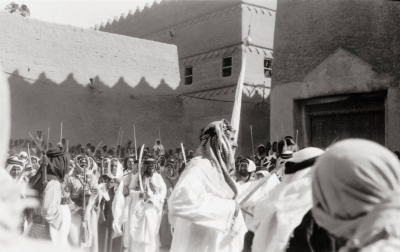
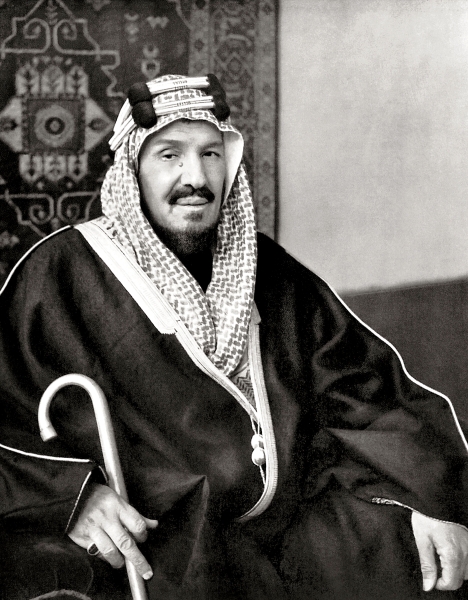
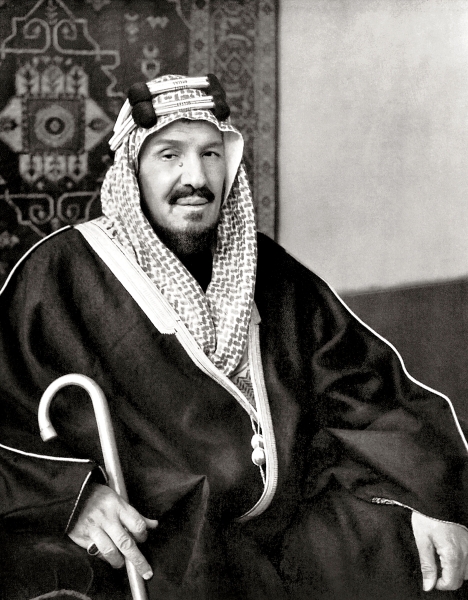
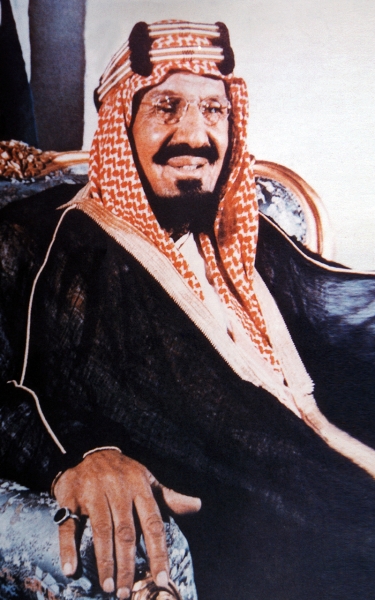
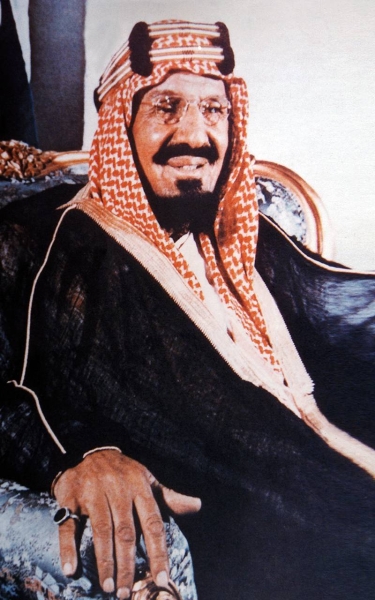
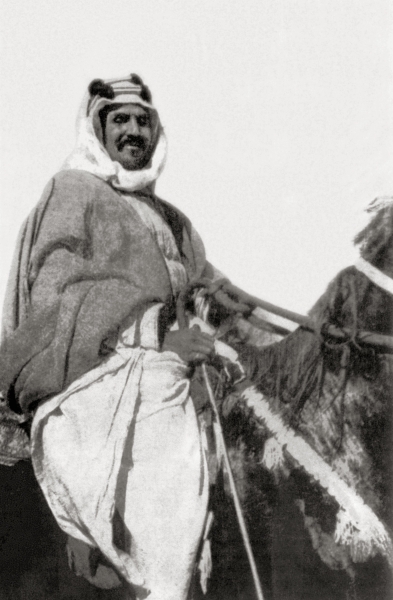
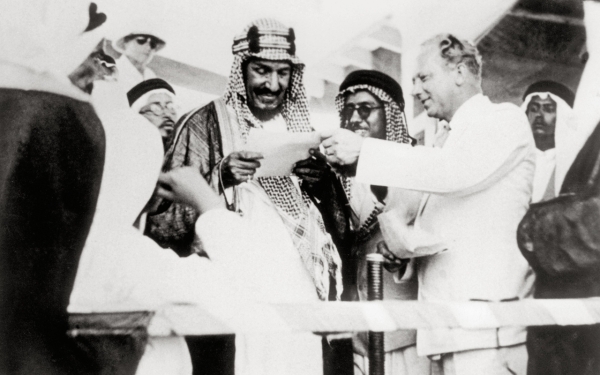
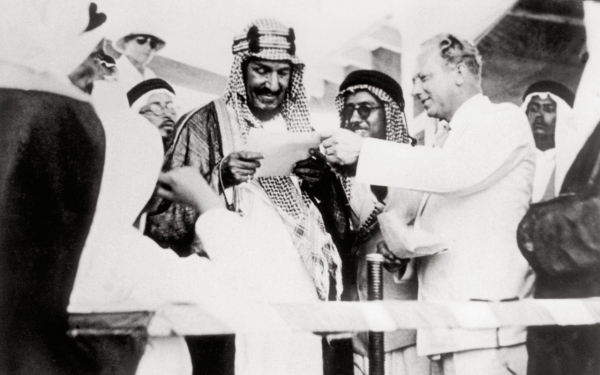
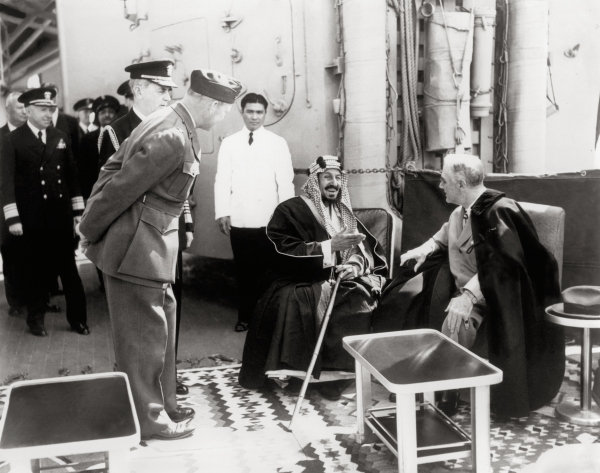
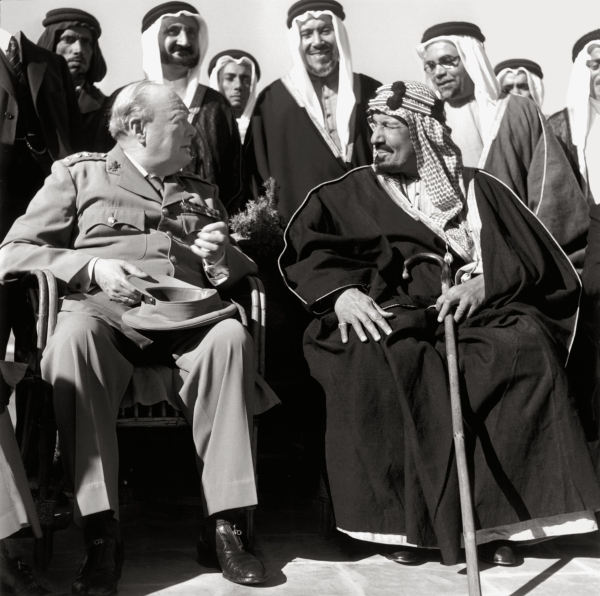
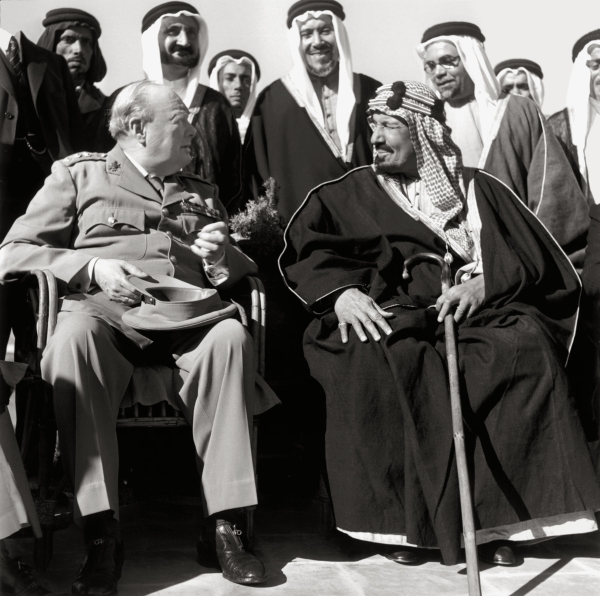
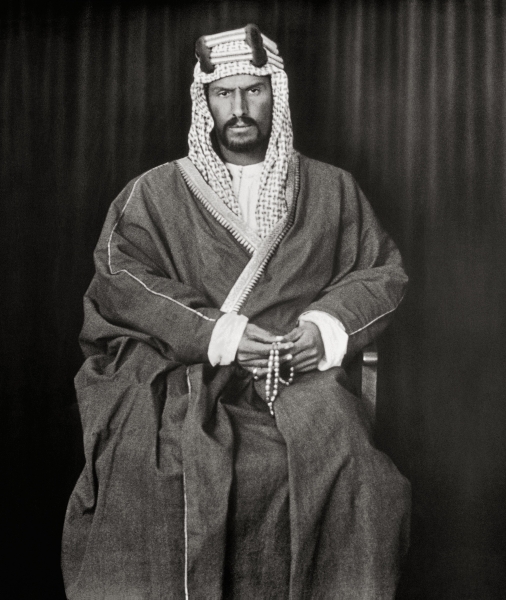
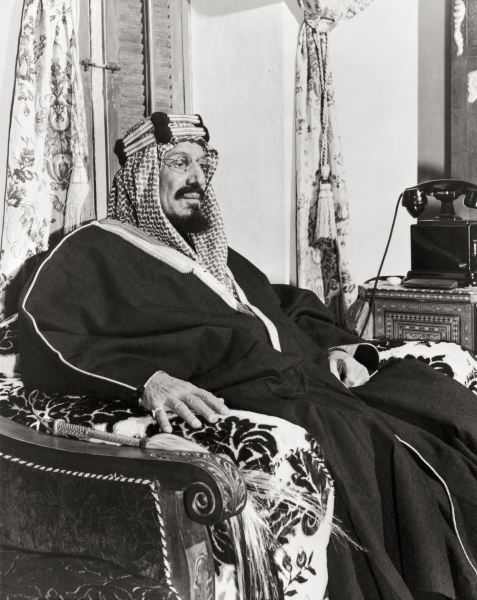
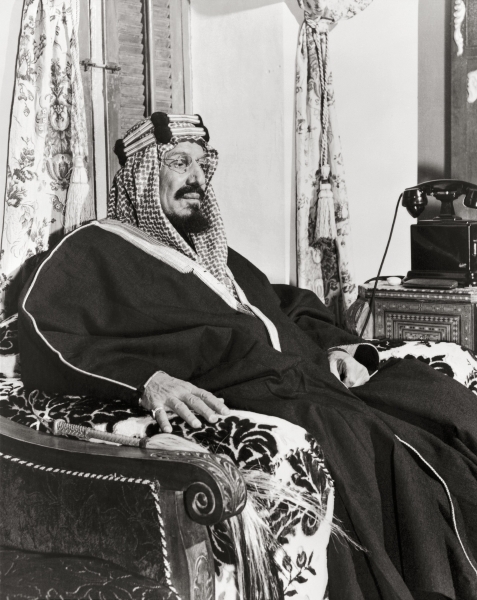
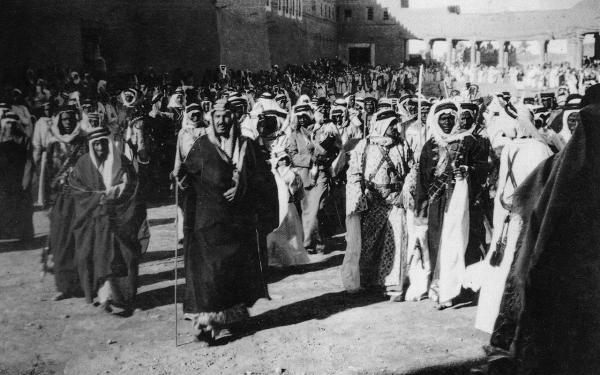
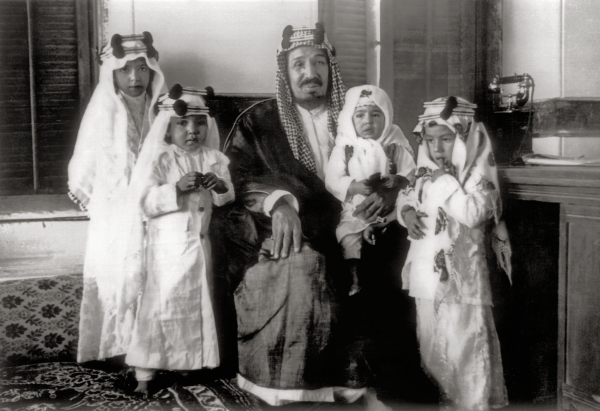
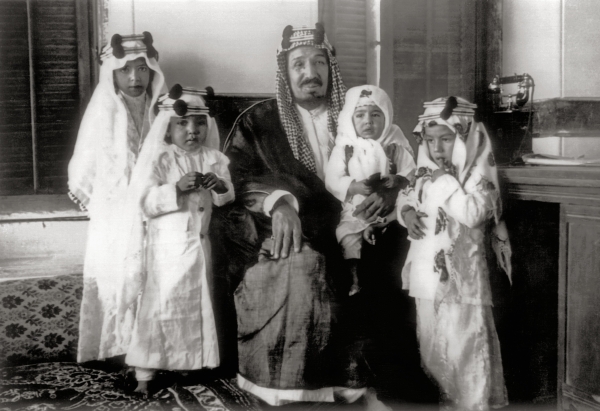

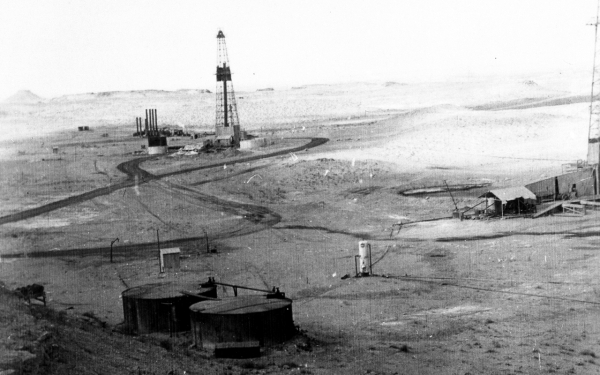
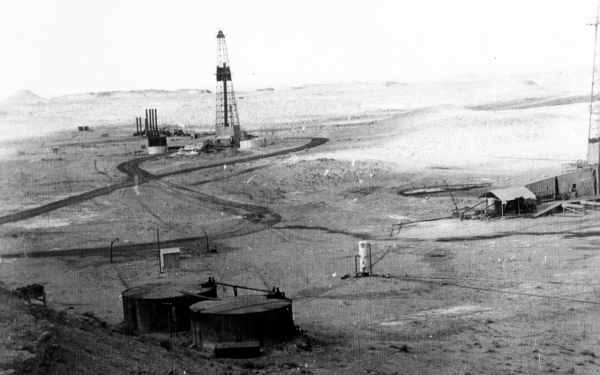
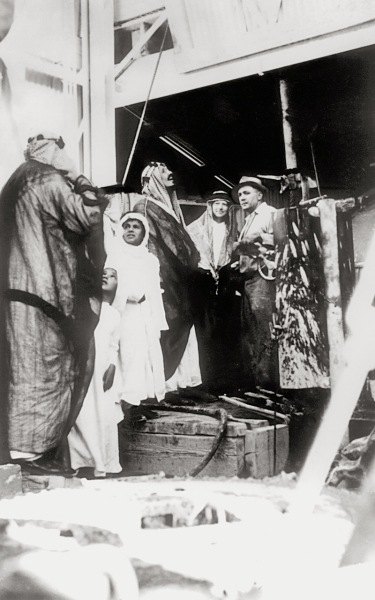
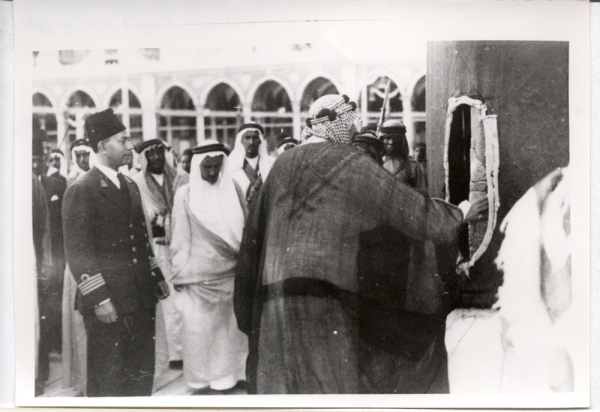
King Abdulaziz Bin Abdulrahman Bin Faisal Bin Turki Bin Abdullah Bin Mohammed Bin Saud (1877 - 1953) was the founder and unifier of the Kingdom of Saudi Arabia, and its first king. He was titled the Sultan, Ibn Saud, and Mu'azi (comforter), and was known as Abu Turki. He was the son of the last Imam of the Second Saudi State, Imam Abdulrahman Bin Faisal, and the ninth ruler from Al Saud family. He assumed the rule in his twenties and ruled for fifty-four years, making him the longest-reigning ruler in the history of the Saudi state.
Lineage of King Abdulaziz
He is Abdulaziz Bin Abdulrahman Bin Faisal Bin Turki Bin Abdullah Bin Mohammed Bin Saud Bin Mohammed Bin Muqrin Bin Markhan Bin Ibrahim Bin Musa Bin Rabi'ah Bin Mani' al-Muraydi from Banu Hanifah, from Bakr Bin Wail, from Rabi'ah Bin Nizar Bin Ma'ad Bin Adnan.
His father, Imam Abdulrahman, was the fourth son of Imam Faisal Bin Turki, one of the rulers of the Second Saudi State, which ruled from 1824 to 1891. His mother, Princess Sarah Bint Ahmed al-Sudairi, was born and raised in al-Ahsa, where Imam Faisal Bin Turki appointed her father as the governor of al-Ahsa Emirate. King Abdulaziz had eight brothers: Mohammed, Saud, Abdullah, Ahmad, Musaid, Saad (the second), and Abdulmohsen, and he had a half-brother named Saad who was martyred in the Battle of Kanzan.
King Abdulaziz's roots trace back to the ruling family that established and governed the First and Second Saudi States over three centuries. The origins of Al Saud family's settlement in Diriyah date back to the mid-fifteenth century. At that time, Prince Mani' al-Muraydi, the twelfth great-grandfather of King Abdulaziz, moved with his clan from the eastern part of the Arabian Peninsula to its center, to the lands of his tribe. They settled in Wadi Hanifah in the region of Yamama, where Prince Mani' founded the city of Diriyah, named after the clan 'al-Duru', and it became the nucleus of the First Saudi State. Imam Mohammed Bin Saud, in the middle of February 22, 1727, established it as the capital of his new state.
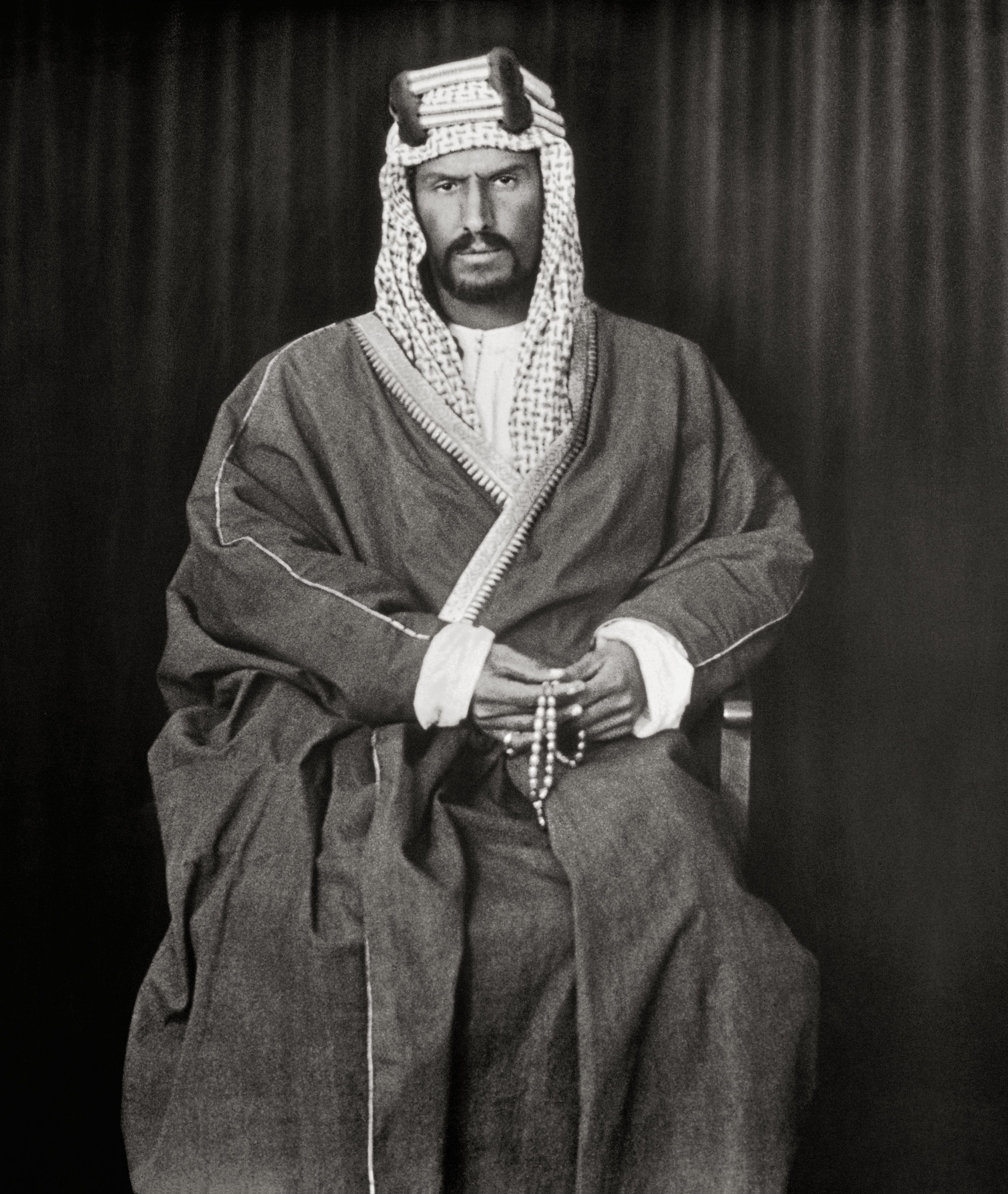
Birth and early life of King Abdulaziz
King Abdulaziz was born on January 4, 1877, in Riyadh City, the capital of the Second Saudi State. He was raised under the care of his father, Imam Abdulrahman Bin Faisal, and his mother, Princess Sarah al-Sudairi. He learned to read, write, and recite the Quran by the age of seven. By the age of ten, he was studying Islamic Sciences and Arabic language studies. In addition to his academic education, he also learned horse riding and developed equestrian skills.
King Abdulaziz experienced a period of internal turmoil over governance during the early years of his life. He participated in delegations under the rule of his father, Imam Abdulrahman Bin Faisal, when he was not yet fifteen years old.
After the fall of the Second Saudi State in 1891, King Abdulaziz left Riyadh at the age of sixteen and wandered with his father and family through the desert regions between Qatar, Bahrain, and al-Ahsa, among the territories of 'Al Murrah' and 'al-Ajman' tribes. During this time, his father, Imam Abdulrahman, relied on him for political correspondence. Shortly after leaving Riyadh, Abdulaziz was sent by his father to Sheikh Isa Bin Ali Al Khalifa, the ruler of Bahrain at the time, to request permission for the women of his family to stay in Bahrain. This request was made out of concern for their safety due to the unstable security conditions in the desert. Sheikh Isa agreed to this request.
Imam Abdulrahman moved to Qatar and stayed there for about four months before relocating with his family to Kuwait at the beginning of 1893. This movement through the desert and his search for a location close to Riyadh were part of his strategy to keep informed about the situation in Riyadh and to be prepared for a potential return. King Abdulaziz strengthened his experience in the desert from the continuous movement and the events that accompanied his family's journey. Through this experience, he became familiar with the nature of the desert tribes, the geography of the region in terms of routes and resources, and the administrative conditions of the surrounding provinces.
King Abdulaziz's life in Kuwait
Imam Abdulrahman's family settled in Kuwait in 1893, where King Abdulaziz lived for nine years. During this time, he remained well-informed about political developments and the general situation in Najd through interactions with Najdi traders and scholars visiting Kuwait, as he awaited a suitable opportunity to return to Riyadh and restore the rule of the Saudi state. At the age of nineteen, he married a girl from the desert, but she died after six months. He later married Wadha Bint Mohammed Bin Burghash from Al Urai'ar family, with whom he had his first son, Turki, followed by Saud, who became the second king of Saudi Arabia, and then Munira.
During his stay in Kuwait, King Abdulaziz witnessed numerous local and global events that enriched his political experience. He became acquainted with the political developments occurring in Kuwait, benefited from his father's experience and guidance, and was encouraged by his elder sister 'Nourah,' whom he greatly admired and proclaimed 'I am the brother of Nourah.' This all contributed to shaping his leadership personality, which he later employed in planning and preparing for the recapture of Riyadh, and subsequently unifying the country and building the state.
The early mandates in King Abdulaziz's life
King Abdulaziz's first military action was participating alongside his father, Imam Abdulrahman, and Sheikh Mubarak al-Sabah in the Battle of Sarif on March 17, 1901. This engagement came after his father received a message from supporters in Najd expressing their loyalty and readiness to support him. The allied forces confronted Ibn Rashid's men at a location between al-Turufiyyah and al-Sarif in Qassim Province, and their battle continued all day.
Before reaching al-Sarif, specifically at a location called 'Ghadir al-Shawki', King Abdulaziz detached from his father's army with a force estimated at one thousand fighters, heading towards Riyadh as part of a plan to restore the rule of the state. Despite the long distance between al-Shawki and Riyadh, he covered it in two days. Upon arrival, he faced Ibn Rashid's garrison and fought them until they retreated and fortified themselves inside al-Masmak Palace. He then besieged them for forty days, but eventually had to lift the siege and leave Riyadh after receiving news that al-Sarif battle didn't end as planned.
The Riyadh restoration phase
Planning to restore Riyadh
The events leading to the restoration of Riyadh began after Imam Abdulrahman's return from the Battle of al-Sarif. King Abdulaziz persistently urged his father to make another attempt to move towards Riyadh. He made significant efforts to persuade him, even enlisting his mother as a mediator between them. Sources recount that King Abdulaziz was strongly resolved and determined to make such an attempt.
Imam Abdulrahman agreed to his son's departure and provided him with modest supplies barely sufficient for the journey, consisting of forty Dhulool, a type of swift-running camel, thirty rifles, and SAR200 (the currency that was used at the time). King Abdulaziz then gathered his men, consisting of forty close family members and followers, and departed from Kuwait in July 1901, which was five months after his first attempt at the Battle of al-Sarif.
The road to Riyadh
King Abdulaziz traveled from Kuwait towards al-Uyayna (known as Ainat Kinhar) north of al-Ahsa. During his journey, he raided several tribes loyal to Ibn Rashid and achieved successive victories in battles. He aimed to rally men around him and demonstrate his strength in preparation for entering Riyadh. His victories became well-known among the tribes, leading many to join his ranks, eventually amassing about 1,400 fighters. With this force, he headed west towards ad-Dahna' Desert. After five days of marching, they reached 'Hafr al-Atk,' where he sent scouts towards Riyadh to assess the possibility of attacking and to gather information about its conditions. He waited for them until they returned with news that it was not the right time to advance towards Riyadh.
King Abdulaziz postponed his entry into Riyadh at that time and continued his movements towards loyal tribes to Ibn Rashid in Wadi Najd where he was victorious. These movements aimed to prepare his men for the reconquest of Riyadh and to assess the ease of movement in areas that were under Ottoman influence at the time, around al-Ahsa. He then returned with his men to al-Ahsa and changed the course of their return. King Abdulaziz stayed in al-Ahsa for about four days before moving westward. He launched another raid on some tribes in the Sudayr desert and then headed towards Binban near Riyadh. This particular raid significantly increased the number of his men, reaching about 2,100, including camel riders and horsemen.
Ibn Rashid, allied with the Ottoman Empire in al-Ahsa, requested them to tighten restrictions on King Abdulaziz and his men, preventing them from accessing supplies and accommodation in al-Ahsa. His request was granted, leading to increased difficulties for King Abdulaziz, who was forced to move south towards Harad. As a result of these hardships, some of his fighters dispersed. To maintain the morale of the remaining men, he prepared them for one final campaign on Thulaima, southeast of al-Kharj, aiming to demonstrate his strength despite Ottoman interference. Eventually, most of his men scattered, and only the forty individuals who had originally left Kuwait with him, plus an additional twenty-three who had joined along the way, remained. With these loyal followers, he covertly moved towards Yabrin, where he devised a plan of concealment and secured supplies for himself and his men.
While King Abdulaziz was settled in Yabrin, an envoy from his father arrived, requesting that he cease his movements and return to Kuwait. King Abdulaziz gathered his men, shared the contents of the message, and expressed his desire to continue his mission. King Abdulaziz then gave his companions the choice to either return or stay with him. Everyone chose to remain by his side until the end. Facing increased pressures due to supply cutoffs and surveillance of his movements, King Abdulaziz informed his companions of a new strategy based on secrecy and sudden strikes with a small number of men. He decided on complete concealment and led them to the sands of al-Jafurah, north of al-Rub' al-Khali (Empty Quarter) desert—an uninhabited region with harsh terrain. His goal was to remain hidden from view while preparing to march towards Riyadh. He relied on his early life experiences of traveling with his father through the desert of the Empty Quarter, which provided him with a knowledge of the geography, resources, and routes of the province. They stayed in the sands of al-Jafurah for fifty days under harsh climatic conditions, from November to December 1901.
The restoration of Riyadh
After spending fifty days in the sands of al-Jafurah, King Abdulaziz and his men left for Riyadh, implementing his secret strategy intended to cut off news of his whereabouts and obscure his trail. This was meant to deceive his opponents into thinking he had ceased fighting and returned to Kuwait. He also waited for the onset of winter to take advantage of its dark nights, allowing for completely secretive movements. Due to the harsh winter conditions in al-Jafurah, the camels carrying them suffered, and were described by sources quoting King Abdulaziz as 'poor'. King Abdulaziz chose an opportune moment to leave al-Jafurah on the twentieth day of Ramadan, a time when Muslims were focused on fasting and worship, meaning fewer commercial caravans were traveling through the area, thus providing a better opportunity for free movement. The journey from al-Jafurah to Riyadh took fifteen days.
King Abdulaziz and his men advanced until they settled in the slope of "al-Shaqib," part of "Jabal Abu Ghareb," south of Riyadh, on the night before the battle. There, he began implementing his plan by dividing his army into three groups. The first group, consisting of twenty-three men, served as a reserve force stationed in al-Shaqib to protect the camels. The second group, composed of thirty-three men under the command of his brother Mohammed, was positioned close to the entrance of Riyadh for protection. King Abdulaziz himself led the last group, which included seven of his men: Abdulaziz Bin Jalawi, Fahd Bin Jalawi, Abdullah Bin Jalawi, Nasser Bin Saud, al-Ma'shouq, Ibn Subaan, and they walked into Riyadh.
King Abdulaziz reached the courtyard of al-Masmak Palace, the residence of the governor of Riyadh. He planned to attack Ajlan in his home without causing harm to the city's residents. They stealthily entered the houses opposite the palace and learned that Ajlan was sleeping with his guards inside al-Masmak Palace. After securing their position, King Abdulaziz summoned the group led by his brother Mohammed, who were camped near the entrance of Riyadh, to join him. At dawn on January 15, 1902, King Abdulaziz and his men attacked the palace, engaging in a brief battle with the garrison of Ajlan Bin Mohammed al-Ajlan, the then Governor of Riyadh. The conflict resulted in the death of Ajlan and some of his men, while the remainder surrendered. The successful assault led to the proclamation that the rule belonged to Allah and then to Abdulaziz, marking the restoration of his ancestral capital and the beginning of a new era, ten years after the fall of the Second Saudi State.
Saudi Arabia holds in high esteem the participants who joined King Abdulaziz in the Battle of Riyadh, known as al-Ruwad (the pioneers), and as King Abdulaziz’s loyal men. Their unwavering support and loyalty to King Abdulaziz during what is considered the most challenging phase in the establishment of the modern Kingdom are highly celebrated. These men journeyed with him from Kuwait, traversing through al-Ahsa, the deserts of Najd, and al-Jafurah Desert under harsh climatic conditions for about six months, participating in all his battles against various tribes. Additionally, in recognition of their contributions, King Fahd Bin Abdulaziz Al Saud issued a directive in 1999 that the Pioneers be honored with a special medal called "The Order of the Pioneers." This honor is awarded to their families during the national celebrations marking the centennial of the founding of Saudi Arabia.
The allegiance to King Abdulaziz as the Ruler of the State
After entering al-Masmak Palace and declaring the restoration of Al Saud rule, King Abdulaziz began reconstructing the walls of Riyadh city, which had been previously demolished. The construction continued for forty days. Then, he sent one of his men, Nasser Bin Saud, to Kuwait to convey the news of King Abdulaziz's victory to his father, Imam Abdulrahman, and Sheikh Mubarak al-Sabah, requesting reinforcements. A month later, Prince Saad, King Abdulaziz’s brother, arrived with one hundred men and some ammunition. Additionally, many residents of Najd joined King Abdulaziz's ranks, bolstering his forces to about one thousand men.
Imam Abdulrahman arrived from Kuwait accompanied by the Saudi family. King Abdulaziz informed him that he was willing to hand over the emirate to his father and serve as a soldier under his command. However, the father initially refused to take the emirate. After the intervention of scholars and his close advisors, King Abdulaziz accepted the leadership on the condition that his father would provide ongoing supervision and guidance as needed. In 1902, King Abdulaziz officially assumed rule in a public ceremony. At that time, his father announced his abdication and presented King Abdulaziz with the sword of Imam Saud al-Kabir, the third Imam of the First Saudi State.
The beginning of King Abdulaziz's journey to unify Saudi Arabia
After restoring rule in Riyadh, King Abdulaziz led the largest national unification process in the history of the Saudi State since its inception. He spent thirty-two years unifying most parts of the Arabian Peninsula, which contributed to the restoration of security and stability, enhancing national unity. King Abdulaziz's political influence became well recognized by neighboring countries at that time, and his achievements attracted the attention of authors and writers from Arab and Western countries. He gained a significant personal stature, in addition to his political status.
Outskirts of Riyadh and Qassim
The stages of unifying the country progressed gradually, and some regions peacefully entered under the rule of King Abdulaziz. After proclaiming the rule for Al Saud, the people of al-Kharj, al-Hariq, al-Hawtah, Wadi ad-Dawasir, and al-Aflaj came forward to pledge their allegiance and obedience. Then, in 1903, King Abdulaziz faced Ibn Rashid's army and defeated them in the Battle of ad-Dilam. This loss diminished Ibn Rashid's influence in the province, which assisted King Abdulaziz in expanding northward in 1904, incorporating al-Mahmal, ash-Shu'aib, Shaqra, Tharmada', and al-Washm until he managed to fully annex the entire region of Sudayr.
King Abdulaziz extended the borders of his emirate to the Qassim Province west of Riyadh, after annexing the region of as-Sirr. Al Muhanna, the rulers of Buraydah at the time, and Al Saleem family, the rulers of Unaizah from Kuwait, came to pledge their allegiance. In 1904, King Abdulaziz's forces attacked Unaizah and successfully annexed it. In the same year, they besieged Buraydah, and the garrison led by Abdulrahman Bin Dabaan, representing Ibn Rashid, was compelled to surrender. This facilitated King Abdulaziz's subsequent annexation of all the towns in Qassim.
Ibn Rashid returned to Riyadh with reinforcements from the Ottoman Empire, consisting of units from the regular army. King Abdulaziz met them in the Battle of al-Bukayriyyah in 1904, which ended in a draw between the two armies. However, King Abdulaziz regrouped his forces and confronted them again in the same year at the Battle of ash-Shinanah. He adopted a new military strategy, splitting his army into two divisions; one faced Ibn Rashid's army, and the other confronted the Ottoman regular army, achieving victory with this approach. Ibn Rashid attempted another attack in 1906, advancing with his army to Rawdat Muhanna east of Buraydah. However, King Abdulaziz managed to defeat him, and the battle ended with Ibn Rashid's death and his army's retreat to Hail, led by his son Mutaib, who later made peace with King Abdulaziz. Consequently, the entire province of Qassim came under the rule of Al Saud.
Al-Ahsa and al-Qatif
King Abdulaziz wanted to expand towards the eastern fringes of the Arabian Peninsula and was keen on annexing al-Ahsa to extend his state’s borders to the sea, which would increase its economic significance. In 1913, he departed from Riyadh with a secretive expedition heading towards al-Ahsa. Upon reaching the wall of al-Kut that surrounded the city of al-Ahsa, King Abdulaziz’s men climbed over it, and declared the inclusion of the territory under the rule of Al Saud family. The Ottoman forces weakened and surrendered, subsequently leaving for Iraq by sea. King Abdulaziz then succeeded in annexing the rest of al-Ahsa regions.
Aseer
The Aseer Province located in the southwest of the Arabian Peninsula, was under the emirate of Al Aidh family. The northern borders of their emirate were close to the modern Saudi state. Some tribal leaders from that area sought refuge with King Abdulaziz, complaining about Al Aidh's rule. King Abdulaziz sent directives regarding this issue, but they were refused, prompting him to send an army led by Prince Abdulaziz Bin Musaid Bin Jalawi. They met in the Battle of Hijla in 1920, and Abdulaziz managed to enter Abha and annex it up to the western borders of the Sulaimaniyah district. However, Al Aidh family attacked Abha later, and took control of it during King Abdulaziz's campaigns in Hail. After completing the annexation of Hail to the Saudi rule, King Abdulaziz sent an army led by his son, Prince Faisal (later King Faisal), in 1922, and successfully reinstated Aseer under Saudi rule.
Hail
Between 1915 and 1919, military movements by King Abdulaziz's forces towards the fringes of Hail took place, and fighting between Al Rashid family and King Abdulaziz's forces reignited due to Al Rashid's violation of a peace treaty with Al Saud family. In response, King Abdulaziz faced Al Rashid army, and several battles ensued, the most significant being the Battle of Jarab near the governorate of al-Zulfi. King Abdulaziz then sent forces to Hail, which besieged the city for two months until it surrendered and joined his rule in early 1922.
Hejaz
King Abdulaziz sent his forces, led by Sultan Bin Bajad, towards the western parts of the Arabian Peninsula to support Khalid Bin Luai, the Governor of Turbah, who had declared his allegiance to King Abdulaziz. The forces of Sharif Hussein Bin Ali, led by his son Abdullah Bin Hussein, attacked Turbah and devastated its people. However, this did not last long, as Sultan Bin Bijad and Khalid Bin Luai launched a surprise and significant attack in 1919, resulting in a decisive defeat for Sharif Hussein's forces, with few survivors. Following his victory in Turbah, King Abdulaziz began his advance towards the Hejaz, particularly after the United Kingdom sent him a message urging him to stop at the borders of Turbah and not to advance further into other areas of the Hejaz.
In retaliation for his defeat in the Battle of Turbah, Sharif Hussein prevented the Najdi pilgrims from performing the Hajj pilgrimage. Consequently, King Abdulaziz convened the Riyadh Conference in 1924, presided over by his father, Imam Abdulrahman Bin Faisal, and attended by scholars and leaders from urban and nomadic communities to discuss the Hajj ban. It was decided that the Najdi pilgrims would proceed to perform Hajj despite the prohibition. In response, King Abdulaziz dispatched an army consisting of fifteen brigades to the Hejaz in 1924, and they successfully captured Taif after defeating the forces of Sharif Hussein.
King Abdulaziz's forces headed towards Makkah al-Mukarramah. At that time, Sharif Ali Bin Hussein had left Makkah al-Mukarramah for Jeddah. The Saudi army members entered Makkah al-Mukarramah peacefully, in a state of Ihram, without war, awaiting the arrival of King Abdulaziz. He departed from Riyadh with a group of horsemen and a retinue composed of princes, scholars, and dignitaries from both urban and nomadic backgrounds. Along the way, fifteen brigades joined him, and he would stop for a day or two at various locations to receive delegations from tribes. The journey took twenty-five days, and on November 11, 1924, he entered Makkah al-Mukarramah in the state of Ihram to perform the rituals of Umrah and stayed there for about a month before heading to Jeddah.
In the same year, King Abdulaziz completed the unification of the Hejaz region as al-Lith and al-Qunfudhah peacefully came under his rule. His forces then besieged the city of Jeddah for a period of time, where Hussein Bin Ali and his forces had fortified themselves. During this period, King Abdulaziz sent detachments northwards towards al-Madinah al-Munawwarah and its neighboring cities, eventually annexing them into his rule. Al-Madinah al-Munawwarah, like Makkah al-Mukarramah, entered into his control peacefully. Subsequently, Hussein Bin Ali surrendered and sought peace. The Treaty of Jeddah was signed in 1925, thereby integrating all parts of Hejaz into the Saudi state. King Abdulaziz was proclaimed King of Hejaz on Friday, January 7, 1926, at the Grand Mosque following the Friday prayer near the Bab as-Safa, earning him the title 'Sultan of Najd and King of Hejaz.'
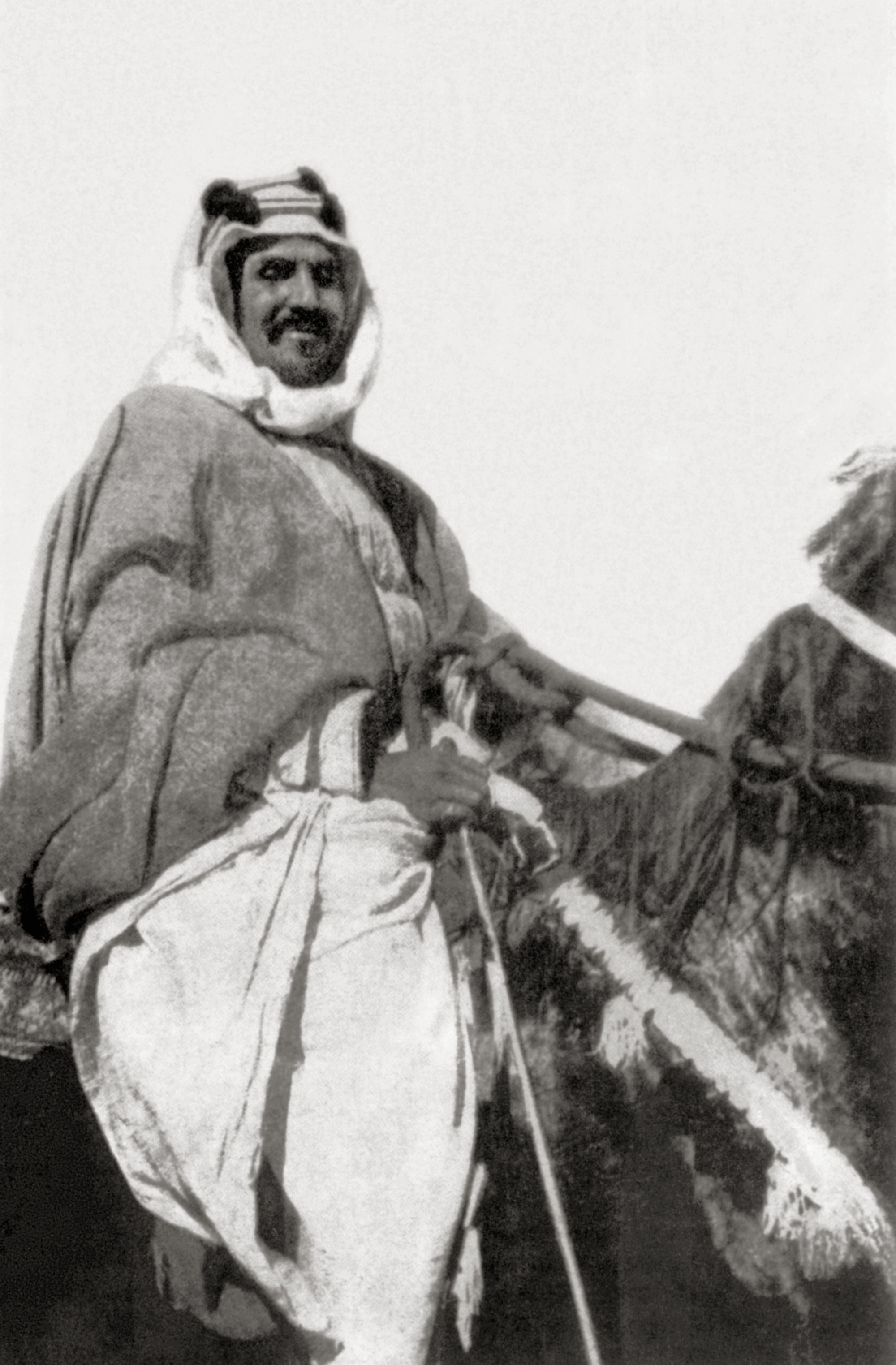
Jazan and Tihama
King Abdulaziz continued his unification campaigns in Jazan and Tihama Aseer Provinces in the southwest Arabian Peninsula after these areas remained under his protection for four years by virtue of the Makkah al-Mukarramah Treaty. This treaty was signed between the founding King and al-Hassan al-Idrisi on October 21, 1926. The Founding King then dispatched his forces to these areas, and al-Hassan abdicated in 1930.
The establishment of the modern form of Saudi Arabia
Naming the state and the law of governance
After completing the unification of his territories, King Abdulaziz named his country the Kingdom of Saudi Arabia. A Royal Order was issued to this effect on September 19, 1932, and September 23 was designated as the day to proclaim the unification of Saudi Arabia and its National Day. He was titled "King of the Kingdom of Saudi Arabia." The state was established as a sovereign Arab Islamic country, with Islam as its religion, the Quran and the Sunnah of the Prophet Muhammad, peace be upon him (PBUH), as its constitution, Arabic as its official language, and Riyadh as its capital. The foundations of governance were laid on principles of national unity, justice, consultation (Shura), and equality.
Council of Deputies (Council of Ministers)
The formation of the government began gradually after the annexation of the Hejaz, as King Abdulaziz aimed to establish administrative structures in line with a modern state. Upon his entry into Makkah al-Mukarramah, he gathered the city's notables and scholars and asked them to elect members for a council that would serve as an advisory body. A meeting was held with the residents for this purpose on December 19, 1924, leading to the formation of "al-Majlis al-Ahli" (the Local Council), which later evolved into the "Majlis al-Shura" (Consultative Council). The first council, composed of dedicated members, was established in 1927 with its headquarters in Makkah al-Mukarramah. It remained influential in most of the state's legislative and regulatory activities, particularly in Hejaz, until the establishment of the Council of Ministers.
King Abdulaziz appointed his son, Prince Faisal, as the Deputy for Hejaz and established an executive council composed of the heads of government departments. This body later evolved into the "Council of Deputies," chaired by the Attorney General and including the Deputies of Foreign Affairs and Finance, the Chief of the Royal Court and his assistant, and the Deputy Chairman of the Consultative Council. As the number of ministries increased from three at the time of the unification of Saudi Arabia 'Foreign Affairs, Finance, and Interior' to five— 'Interior, Health, Communications, and Knowledge', in addition to the General Directorate of Pilgrimage Affairs and the General Directorate of Petroleum and Minerals—the council members also increased. This Council of Deputies was later replaced by the Council of Ministers in 1953. It was scheduled that the council would open on December 7, 1953, but the death of King Abdulaziz two months later postponed its inauguration to March 7, 1954, during the reign of King Saud Bin Abdulaziz Al Saud. The council's responsibilities included formulating Saudi Arabia's domestic, foreign, financial, economic, and educational policies, issuing civil and military laws, ratifying international agreements, and establishing a law for the ministries that defined their powers and duties. Thus, the Prime Minister became the principal official responsible for all ministries and government departments.
Additionally, the "Public Prosecution" was established to serve as the general reference for all government departments and their administrative divisions. Directors and heads of government departments are accountable to the Public Prosecution for the internal operations within their areas of responsibility. The Public Prosecution is accountable to the king, with military affairs excluded from its responsibilities. The Attorney General oversees both the administrative and consular divisions.
Defining the administration of the provinces
King Abdulaziz wanted an administrative division for the state's vast regions due to security needs, environmental conditions, difficulties in transportation, and population distribution. He approved the division of the northern region of Saudi Arabia into the Western Border Inspectorate and the Northern Border Inspectorate. Before the inclusion of Hejaz, the main provinces were Najd, Qassim, al-Ahsa, Aseer, Hail, then Jazan, Najran, and Hail. King Abdulaziz sent inspection teams to various provinces and personally reviewed the state's administrative achievements with the Attorney General at the end of each year. He appointed princes to govern these provinces, totaling sixty-four princes, each with the freedom to manage his emirate as he saw fit according to local customs and norms unless directed otherwise by the king. This arrangement continued until the issuance of the Princes and Administrative Councils Law on February 22, 1940, which defined the powers and responsibilities of the provincial princes and administrative councils.
Crown prince designation
King Abdulaziz frequently tasked his eldest son, Prince Saud, with managing Najd's affairs during his departures and included him in the battles to unify the nation, sometimes giving him command of the army in some battles. Following a suggestion from the Council of Deputies and the Consultative Council to appoint him as the Crown Prince, King Abdulaziz issued a Royal Decree in agreement. Prince Saud was officially pledged allegiance as the Crown Prince on May 22, 1933, and he was also assigned the command of the armed forces on August 24, 1953.
Attorney General in the Hejaz
When King Abdulaziz annexed the Hejaz region into his rule, he established a new position within his modern state structure, following the governmental organization that was prevalent in Hejaz at that time. He appointed his son, Prince Faisal, as the head of the Hejaz government and the reference for its official departments under the title 'The Attorney General for His Majesty the King' on January 13, 1926. Prior to this, Prince Faisal had participated in several military campaigns and had handled numerous domestic political responsibilities.
International Relations of Saudi Arabia
Foreign visits
Since his assumption of rule over Najd during the unification of Saudi Arabia, King Abdulaziz visited several countries. His first such visit was to Kuwait in November 1916. In the same year, he traveled to Basra in Iraq to meet with British officials. He returned to Iraq on February 22, 1930, to meet with King Faisal Bin Hussein, the then King of Iraq. The following day, he headed to Bahrain to meet Sheikh Isa Bin Khalifa, the ruler of Bahrain. Ten years later, on May 2, 1939, he returned to Bahrain and met with Sheikh Hamad Bin Isa.
King Abdulaziz traveled to Egypt on February 14, 1945, to meet with U.S. President Franklin Roosevelt aboard the American cruiser USS Quincy in the Great Bitter Lake in the Suez Canal. Two days later, on February 16, he met with King Farouk of Egypt and President Shukri al-Quwatli of Syria at the Auberge Hotel on Lake Qaroun in Fayoum. The following day, February 17, he met with British Prime Minister Winston Churchill and Foreign Secretary Anthony Eden at the same hotel. The following year, on January 10, 1946, he made an official visit to meet King Farouk again.
Boundary delimitation agreements of Saudi Arabia
The unification of Saudi Arabia coincided with a number of global events, most notably World War I and World War II. During the latter, King Abdulaziz declared his commitment to the principle of neutrality, successfully maintaining the independence and sovereignty of Saudi Arabia. Utilizing principles of international law such as 'consent' and 'mutual concession,' he managed to establish about twenty agreements concerning boundary delimitation and good neighborly relations with bordering states. King Abdulaziz's foreign policy focused on building relations with neighboring countries and securing borders through fair settlements. One of the first such boundary agreements was with the State of Kuwait in the northeast, leading to al-Uqayr Convention chaired by the British High Commissioner in Iraq, Percy Cox, who was chosen by Saudi Arabia and Kuwait to arbitrate between them. The conference concluded with a boundary delimitation agreement between the two states, which was signed on December 2, 1922.
Al-Uqayr Convention included provisions to end the border issues between Najd and Iraq, creating a neutral zone where their tribes could move freely. Both parties were prohibited from constructing outposts or buildings along the boundary line between them. However, this did not prevent some tribes from raiding tribes and trade caravans belonging to King Abdulaziz. In response, he appealed to the Iraqi government and the British High Commissioner to put an end to these raids. The British government then called for a conference in Kuwait, where no agreement was reached. Subsequently, the Bahra Agreement was signed on October 31, 1925, by King Abdulaziz for his country, and Gilbert Clayton, acting as commissioner for the British government and deputy for the Iraqi government. The following day, the Hidda Agreement was concluded to define the borders between Jordan and Saudi Arabia, with the British government representing Jordan.
After numerous battles with the Yemeni government at that time over the borders in the south of the Arabian Peninsula, a delegation came to Hejaz including representatives from various Arab countries. They met with King Abdulaziz and proposed a peace agreement, which he accepted. The forces of both sides were ordered to cease fighting on all fronts, and the Taif Treaty was signed between the Yemeni delegation and the Saudi delegation led by Prince Khalid Bin Abdulaziz on May 20, 1934.
Due to Saudi Arabia being a coastal state flanked by the Arabian Gulf on the east and the Red Sea on the west, international law regarding the extent of territorial waters applies. Each country issues its own legislation individually, as there is no uniform law that defines the territorial sea extent for any nation. In response, King Abdulaziz issued a Royal Decree on May 28, 1949, which established the territorial waters of Saudi Arabia to extend twelve nautical miles and an adjacent zone extending an additional six nautical miles. This decree extends Saudi Arabia's sovereignty over its entire territorial sea, including the airspace above, and the seabed and subsoil beneath it.
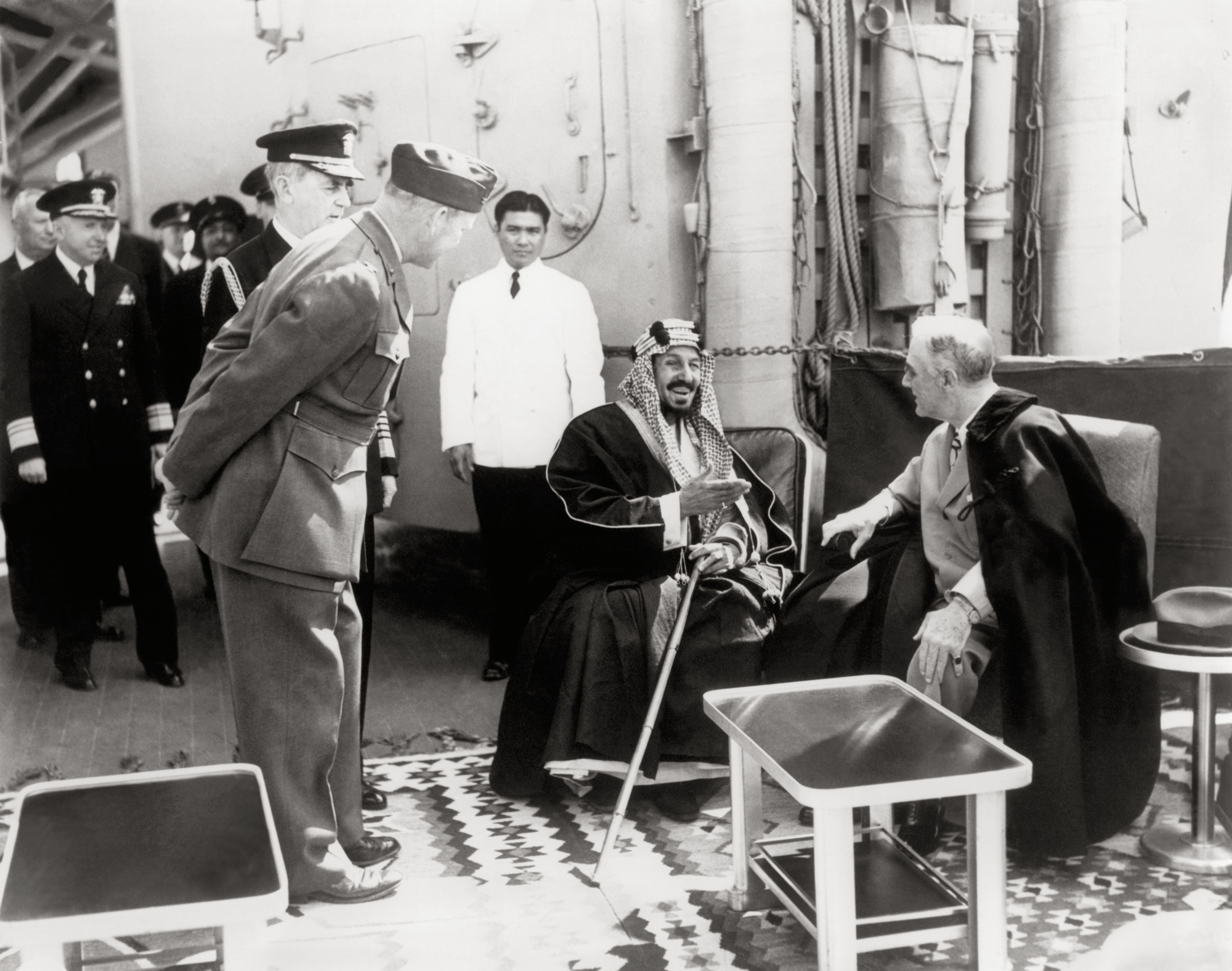
International Friendship Treaties
United Kingdom: Treaty of Darin, December 26, 1915.
Germany: April 26, 1929.
Turkey: August 3, 1929.
Iran: August 24, 1929.
Iraq: April 7, 1931.
Italy: February 10, 1932.
Jordan: July 27, 1933.
Afghanistan: March 17, 1934.
Pakistan: November 25, 1951.
China: November 15, 1946.
France: November 10, 1931.
Kuwait: April 20, 1942.
Egypt: May 7, 1936.
Yemen: December 16, 1931.
Establishment of the Ministry of Foreign Affairs
Before the annexation of the Hejaz region, King Abdulaziz personally managed foreign affairs, corresponding directly with governments and receiving their responses, or overseeing foreign correspondence with the assistance of some of his experienced men adept in handling these matters. At that time, the Sultanate of Najd had limited contact with the outside world, maintaining communication links only with neighboring states with aligned interests.
After annexing Hejaz in 1926, the founding King Abdulaziz began establishing international relations with foreign countries in accordance with the international laws recognized at the time. Consequently, the Directorate of Foreign Affairs was established, with Abdullah al-Damluji appointed as its director. This directorate continued its operations until a Royal Order was issued in December 1930 transforming it into a ministry. Prince Faisal, the second son of the founding King, was appointed as the minister, with Fouad Hamza serving as the deputy of the ministry. This became the first ministry officially established in the government of Saudi Arabia.
The origins of King Abdulaziz's domestic policy
The choice of Saudi Arbia's emblem, featuring two swords and a palm tree, along with its green flag in 1932, enhanced the positive sentiments among the populace, fueled by a need for security and stability. King Abdulaziz, with his courage, wisdom, and sense of responsibility, led numerous initiatives and projects. Among these initial efforts were the settlement of tribes and the promotion of education. He also focused on the care of the Holy Mosques, undertaking necessary works to serve the pilgrims and secure the pilgrimage routes. Additionally, he paid special attention to the sacred sites, ordering the construction of the road between Jeddah and Makkah al-Mukarramah, the expansion of the Holy Mosques, and the provision of fresh water to them.
National unity and the settlement of the bedouins
National unity was one of the significant social achievements that King Abdulaziz was keen to realize. Within the project of national unity was the project of settlement and the establishment of hamlets, which led to the stabilization of many nomadic tribes and their integration into social life, contributing alongside their urban counterparts to the unification and building of Saudi Arabia. King Abdulaziz designed a clear policy to achieve this project, starting with identifying locations with water wells suitable for settlement and allocating these to the tribes. He supported them in building mosques and homes and sent scholars and guides to teach the tribe members in their new settlements the Noble Quran and the principles of Islamic sciences. As a result, these hamlets became bustling centers of activity, particularly in agriculture, as their inhabitants turned to farming and settled life. Modern population centers spread throughout Saudi Arabia, including areas previously devoid of settled inhabitants. It is estimated that King Abdulaziz established around two hundred hamlets, which later expanded and evolved into small towns featuring all modern services with safety and security.
Regulation of judicial affairs
Since King Abdulaziz entered Riyadh and established his modern state, he prioritized the enforcement of justice and equality across all areas under his rule. This was achieved through the implementation of law to everyone without exception, in accordance with the principles of Islamic Sharia derived from the Quran and the Sunnah of Prophet Muhammad (PBUH). In Najd and its dependencies, the judiciary was entrusted to independent judges in the main cities, meaning that each city had a judge responsible for overseeing all cases and general events occurring within his city and its neighboring villages. King Abdulaziz then laid the foundational stone for the establishment of the Saudi judiciary by creating a unified Chief Justice's office in Hejaz, based in Makkah al-Mukarramah, on February 7, 1926. This office was tasked with overseeing the judiciary of Hejaz courts and their affiliates.
In the Hejaz region, King Abdulaziz issued a Royal Decree on August 20, 1927, to establish courts in three tiers: summary courts known as "partial courts," major courts, and affiliated courts, which serve as general courts. Additionally, a Judicial Oversight Authority was established to oversee the judicial system. Alongside these courts, a Commercial Council was formed, functioning as a specialized court dedicated to handling commercial cases.
King Abdulaziz's interest in education
King Abdulaziz showed a profound interest in the scientific aspect from the start of his campaign to unify Saudi Arabia. He valued scholars in high esteem, often including them in his council during both residence and travel. He even accompanied some of them on his military expeditions. A manifestation of his commitment to education was his personal involvement in its development, making it free for all, and allocating substantial stipends to students in various schools, institutes, and colleges. The first major step in this direction was in 1925 when he established the 'Directorate of General Knowledge' to regulate and expand educational opportunities. As a result, government schools were established across the country. The following year, in 1926, the Saudi Scientific Institute was opened to train teachers qualified to teach at the elementary and intermediate levels.
King Abdulaziz was keenly interested in the development of his people and their education in various sciences around the world, believing in their capability to acquire sciences and knowledge. Thus, the idea of foreign scholarships was introduced in 1927 when the first missions were sent to study in Egypt. Eight years later, in 1935, a Preparatory School for Scholarships was established to further support this initiative. Subsequently, schools proliferated broadly, including specialized ones such as Dar al-Tawhid in Taif in 1945, which focused on religious sciences, its branches, and the Arabic language. Additionally, the Scientific Institute in Riyadh and other specialized scientific and military schools were established. The foundation for university education in Saudi Arabia was laid with the establishment of the College of Sharia in Makkah al-Mukarramah in 1950, followed by the College of Sharia in Riyadh in 1954, marking significant milestones in the development of higher education in Saudi Arabia.
Interest in healthcare during the reign of King Abdulaziz
King Abdulaziz cared about healthcare and established clinics and health centers across Saudi Arabia. In 1925, the Public Health Department was established to oversee the organization and development of healthcare within the country. During his reign, numerous medical facilities were established throughout Saudi Arabia, and medical teams were formed to provide treatment and healthcare services to the population in villages and rural areas.
The King's concern extended beyond medical facilities alone to cooperation with international organizations and entities to benefit from their expertise, especially in the field of epidemic prevention. In 1951, the Public Health Department was transformed into the Ministry of Health, with Prince Abdullah al-Faisal appointed as Minister of Health and Interior concurrently. Healthcare continued to evolve, with the provision of modern and advanced equipment and devices.
Care for the affairs of the Two Holy Mosques
Since King Abdulaziz entered Hejaz, he announced the start of renovations for the Two Holy Mosques. In 1925, he issued an order for the complete renovation of the Grand Mosque, including all necessary repairs and expanding the mosque's area. In 1926, as the number of pilgrims increased, he ordered the installation of canopies in the mosque's courtyard to protect worshippers from the sun's heat. In 1927, he ordered another renovation of the Grand Mosque, which included restoration and painting. Additionally, repairs were made to the Ibrahimic canopy, the Zamzam dome, and the Shadhruwan of al-Kaaba, costing approximately GBP2,000 of gold. In the same year, he ordered the construction of canopies around the edge of the Mataf (al-Kaaba courtyard), made of thick white cloth-covered Javanese wood. Later, fixed canopies were installed at the edges of the courtyard, attached to the corridors, and could be unfolded and retracted as needed. These canopies were continuously renewed for many years. Furthermore, he ordered the establishment of a factory specifically for making the coverings of the al-Kaaba al-Musharrafa.
During the period between 1926-1927, an order was made to pave the Masa'a with square flint stones, marking the first time in the history of the Grand Mosque that the path was paved. There was also an order to renovate the old conduit of Zamzam water and to construct two new conduits. In 1935, there were orders for the repair of the stone flooring around the Mataf, the repair of the ground of the corridors, and the restoration and marble cladding of the entire mosque. In 1947, there was an order to renew the roof of the Masa'a area and to construct a new door for al-Kaaba covered with sheets of pure silver. In 1951, there was an order to fully marble-clad the facades facing the Grand Mosque and its courtyards.
King Abdulaziz visited al-Madinah al-Munawwarah in 1926 and reviewed the administrative organization and architectural repairs needed by the Prophet's Mosque. The first of these efforts began in 1929 with the repair of damage caused by subsidence in the floors of the colonnades facing the courtyard of the mosque from all four sides, due to the accumulation of rainwater in the mosque's courtyard. In 1931, he ordered the repair of defects in some of the eastern and western columns and the courtyard, by placing iron bands around the damaged parts.
King Abdulaziz announced on June 8, 1949, his intention to expand the Prophet's Mosque. Necessary studies for the project were conducted, and preliminary works started on June 26, 1951. The area surrounding the mosque from the east, west, and north was prepared, part of the old building was removed, and a new area was added, bringing the total area of the Prophet's Mosque after this expansion to 16,548 m. On December 1, 1952, the then Crown Prince Saud Bin Abdulaziz laid the foundation stone for the construction and expansion on behalf of his father, King Abdulaziz. Work began on excavating the foundations and then on building and construction. The expansion was later completed during the reign of King Saud Bin Abdulaziz.
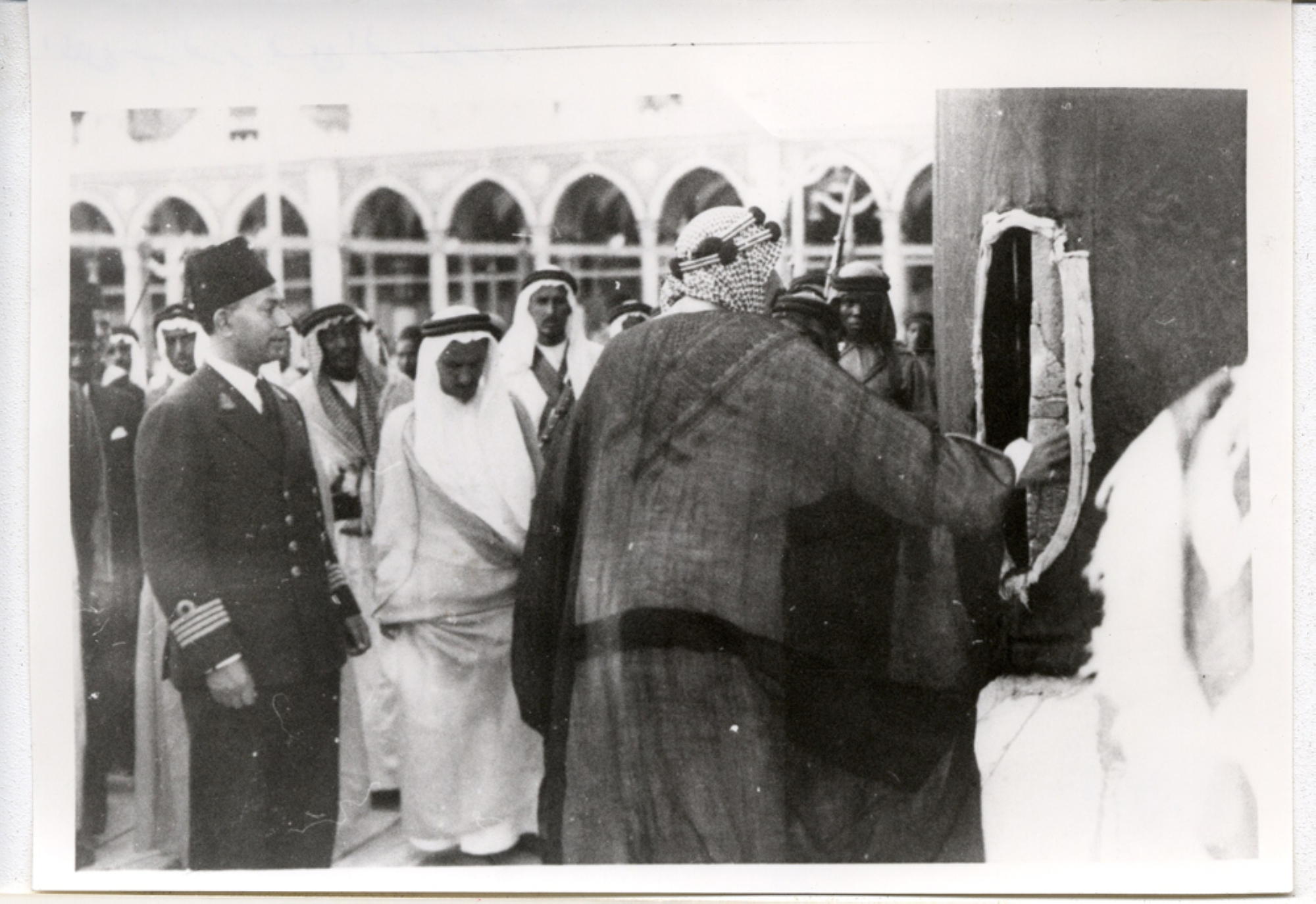
Economic organization during the reign of King Abdulaziz
King Abdulaziz based the financial regulation of the country on Zakat as a primary source of income, in addition to relying on the livestock of the region and the agricultural harvest from various cities and oases of Saudi Arabia. He later expanded the country's revenues through customs duties on goods imported to the eastern and western ports, before the discovery of oil in the region. This marked an extraordinary turning point in the economic situation, propelling the country rapidly towards development and growth.
The establishment of the Ministry of Finance
The first step towards financial regulation in Hejaz was when King Abdulaziz formed a committee in Makkah al-Mukarramah in 1925 to study the financial situation. Two years later, the 'Directorate of Finance' was established with its headquarters in Makkah al-Mukarramah, while the finance office in Jeddah remained unchanged, and its manager was called the 'Custodian of Funds'. Later, the financial departments in Makkah al-Mukarramah and Jeddah were unified under a general administration named 'General Finance Agency', and Abdullah Bin Sulaiman al-Hamdan was appointed as its agent. On August 14, 1932, this agency was transformed into a ministry, with Abdullah Bin Sulaiman becoming its minister. A new law was established for the ministry stipulating that it was the entity responsible for organizing and safeguarding the state's funds, and managing its revenues, and expenditures.
The powers and responsibilities of the Ministry of Finance expanded significantly, with all financial administrations across Saudi Arabia being linked to it. It also encompassed various departments including Hajj, Defense, Agriculture, Public Works, Roads, Vehicles, and Mining, which were later separated from it. An initial attempt to create a budget for Saudi Arabia was made in 1929, and after five years, the first detailed budget was established, documenting revenues that amounted to SAR14 million. By 1948, the budget had increased significantly, exceeding SAR200 million.
Development of the monetary system in Saudi Arabia
Before its unification, Saudi Arabia had various currencies in circulation, including the British or Indian 'Indian Rupee' and the Austrian 'Franc.' The gradual issuance of Saudi currency began with the initial stamping of the words 'Najd' and 'Hejaz'. In 1925, King Abdulaziz issued an order to mint the first metal currency, which included denominations of half a qirsh and quarter qirsh, representing the first purely Saudi currency.
The first regulation of the monetary situation was issued on October 8, 1928, under the name 'Najdi Hejazi Currency System.' This system required transactions to be conducted in the Saudi Riyal, which was minted from silver in the same year across all denominations. On April 20, 1952, King Abdulaziz issued a Royal Decree to establish the Saudi Arabian Monetary Authority, headquartered in Jeddah. This authority was tasked with regulating the issuance of Saudi currency and consolidating its financial value both domestically and internationally.
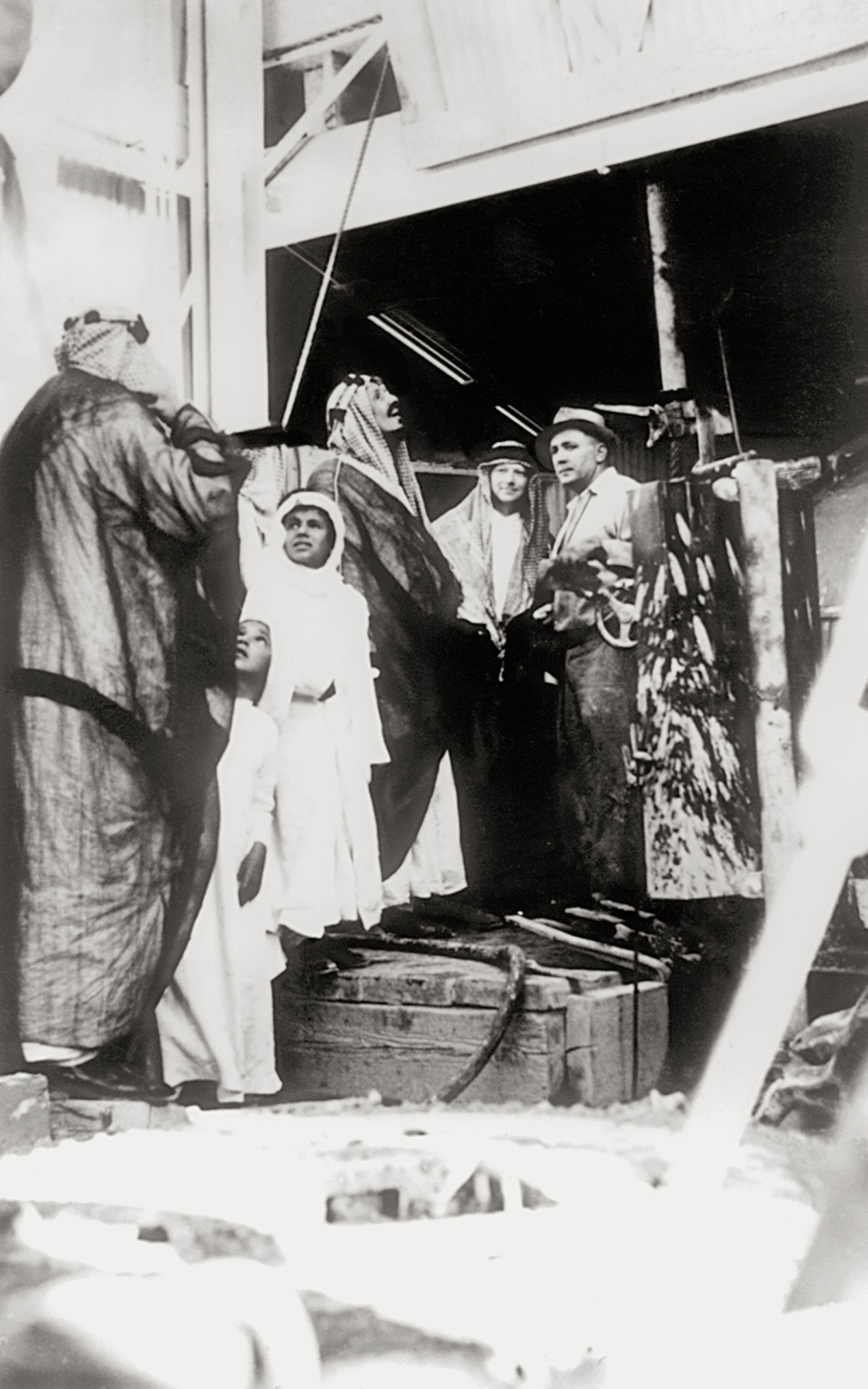
Oil discovery in Saudi Arabia
After the discovery of oil in large quantities globally, King Abdulaziz took an interest in exploring oil and minerals in the territories of Saudi Arabia. In 1923, King Abdulaziz granted an oil concession to a British company, the 'Eastern Syndicate.' However, the company was unable to achieve results from its exploration activities, so King Abdulaziz terminated the concession agreement in 1928. Subsequently, he commissioned the geologist 'Twitchell' to study the potential for minerals in the country after commercial quantities of oil were discovered at ad-Dukhan mountain in Bahrain in 1932, especially since the Eastern Province's geological formation is similar to that of Bahrain.
The concession agreement between Saudi Arabia and the Standard Oil of California (SoCal) was concluded, and a subsidiary called 'California Arabian Standard Oil Company' (CASOC) was established to manage this agreement. Drilling operations began in 1935, and by 1938, successful exploration efforts led to the discovery of oil in commercial quantities at Dammam Well No. 7, which was named 'al-Khair Well.' The company's name was later changed to Aramco ('Arabian American Oil Company'), and by 1949, crude oil production reached five hundred thousand barrels per day.
The company completed the construction of the 'Tapline,' which spans 1,617 km. The Tapline linked the Eastern Province of Saudi Arabia to the Mediterranean Sea, facilitating the export of oil to Europe. After two years of exploration in the Arabian Gulf waters, the Safaniya Oil Field was discovered in 1951, which is recognized as the largest offshore oil field in the world.
Formation of the military sector in Saudi Arabia
King Abdulaziz made extraordinary efforts to establish security and consolidate stability by introducing the country's first security organizations. His responsibility for the safety of the pilgrims led him to intensify his efforts in the security field. He established infantry forces, a morality protection police, mechanized and cavalry units, and traffic police. He also founded a police academy aimed at training officers and their assistants and brought in security specialists to develop these agencies and enhance their performance.
Internal security
Before the unification of Saudi Arabia, the Arabian Peninsula suffered from security disturbances. As King Abdulaziz began annexing provinces of the country, he was keen on enacting new regulations to establish internal security. Among these was the project to settle the nomads and establish the hamlets, which resulted in the stabilization of many nomadic tribes. With the unification of the Hejaz region, King Abdulaziz's focus on security intensified, especially concerning the safety of the pilgrims. He ordered the regulation of the police by establishing the General Directorate of Police on August 2, 1925, headquartered in Makkah al-Mukarramah. Due to his concern for the safety of Hajj pilgrims traveling by land between Makkah al-Mukarramah and al-Madinah al-Munawwarah, King Abdulaziz ordered the establishment of the first road security agency in 1926. Its mandates included informing pilgrims of road hazards and setting up security patrols composed of mounted police and vehicles that would cover the entire Makkah al-Mukarramah-al-Madinah al-Munawwarah route daily.
Subsequently, other police departments were established in various regions of Saudi Arabia, some with specific jurisdictions, such as the Haram Police and the Railway Police. In 1930, all these forces were placed under the supervision of the Director of Public Security. The police forces included infantry, traffic police, cavalry and mechanized units, and morality protection police. A police academy was established in Makkah al-Mukarramah in 1935 to train officers and their assistants to contribute to security management. In 1944, the General Directorate of Police was transformed into the General Directorate of Security. In 1950, a new police system was introduced, which included new formations in its various departments.
The armed forces during the reign of King Abdulaziz
During the unification operations, King Abdulaziz's forces consisted of his loyal followers, the men of the desert 'Ikhwan Army' and the men of the settled areas 'Jihad Army.' He would call them to war and they would gather under his banner, relying on their capabilities in armament and supplies. These two armies marked the beginning of what was then called the Saudi Army, the first regular military force in Saudi Arabia. Then, in 1929, the founding King saw the importance of developing his forces in terms of organization and armament. He ordered the formation of the first core of the regular Saudi Army units, consisting of three sectors: infantry battalions, artillery, and machine guns.
Building on the founding King’s commitment to establishing an air force to protect the skies of Saudi Arabia, King Abdulaziz issued a Royal Order on January 8, 1926, to establish an aviation force named 'Hejazi Najdi Air Force'. Subsequently, on December 30, 1929, he decided to purchase four British-made Westland Wapiti Mark II biplanes, which were among the most advanced aircraft used at that time. The first airport was prepared for these aircraft on Darin Island in the Eastern Province. The Air Force system evolved with the establishment of a flight school and sending missions abroad to study aviation sciences.
King Abdulaziz ordered the establishment of the Military Academy on September 15, 1934. Later, the General Staff Headquarters was established in 1939, and military uniforms were standardized. This entity was transformed into the Ministry of Defense on November 10, 1943. The name of the Ministry of Defense was changed on April 1, 1952, to the Ministry of Defense and Aviation and the Inspector General, incorporating both military and civil aviation under its banner.
Developmental establishment during the reign of King Abdulaziz
Transportation
King Abdulaziz showed a keen interest in transportation means, introducing automobiles to Saudi Arabia for his personal use, official state purposes, and for transporting goods, travelers, and pilgrims. The government began paving roads between provinces of Saudi Arabia and established the first railway between Dammam and Riyadh in 1952. The government also turned its attention to air transportation, purchasing four civil aircraft, which number quickly increased thereafter. The 'Saudi Arabian Airlines Aircraft Administration' was established, with Jeddah hosting the first civil airport at that time. Additionally, King Abdulaziz's government focused on maritime transportation, forming the first maritime transport fleet. Efforts were made to improve the maritime ports in the western and eastern parts of Saudi Arabia and to establish new ports, including the Jeddah Islamic Port on the Red Sea and the Dammam Port on the Arabian Gulf.
Telecommunication
In the field of communications, the government of King Abdulaziz made significant strides by joining the Universal Postal Union and establishing agreements with many countries for telephonic, telegraphic, and postal communication. Saudi Arabia also developed a telephone network that connected various provinces and sent numerous students abroad to acquire technical and administrative expertise in communications. Additionally, wireless schools were established for education and training in Makkah al-Mukarramah and Riyadh.
Water and Agriculture
King Abdulaziz prioritized water availability and agricultural development in Saudi Arabia. One of the first efforts in this direction was to bring in specialists in 1931 to search for water sources. He also brought the first technical mission to develop agriculture in 1934. Subsequent studies and missions continued until the establishment of the Directorate of Agriculture in 1948, with branches opened across Saudi Arabia. Among its activities was the installation of two large water distillation machines in Jeddah in 1926, the creation of Ain al-Waziriya in 1933, and Ain al-Aziziya in 1947. Additionally, King Abdulaziz founded a committee to develop Ain az-Zarqa in Madinah al-Munawwarah and established the Ain Zubaydah authority in 1934.
King Abdulaziz's government also focused on the restoration of water dams, drilling of artesian wells, and exempting agricultural equipment from customs duties to support farmers. It imported machinery and equipment to aid farmers, provided assistance to small-scale farmers, established banks to lend to them, and educated them on modern farming techniques and crop protection from pests. Additionally, the government initiated al-Kharj agricultural project, reclaimed lands, introduced new crops, and established mechanical workshops to repair water pumps and agricultural machinery.
Saudi broadcasting
Saudi radio broadcasting began during the reign of the founding King who was keen on ensuring that his country kept pace with global civilizational advancements. On Tuesday, July 19, 1949, a Royal Decree was issued establishing the general framework for Saudi Broadcasting. In it, King Abdulaziz emphasized the importance of honesty, integrity, and realism in all broadcasts. He mandated objectivity and ethical standards to ensure that no one is insulted or subtly criticized, nor is undue praise given inappropriately. He also stressed the importance of focusing on religious matters, broadcasting the Holy Quran, and religious sermons.
The first Saudi radio station was established in Jeddah, and it began broadcasting on October 1, 1949, which corresponded to the Day of Arafah. The station was inaugurated with a speech delivered by Prince Faisal, acting on behalf of his father, the founding King. His speech included greetings to the pilgrims and welcomed them to the holy lands. The launch of the broadcast followed the signing of a contract with a foreign company, which facilitated the establishment of 'Jeddah Station' and the creation of additional studios in Makkah al-Mukarramah. The contract between the Saudi government and the company was signed at the Saudi Embassy in Cairo on May 11, 1949.
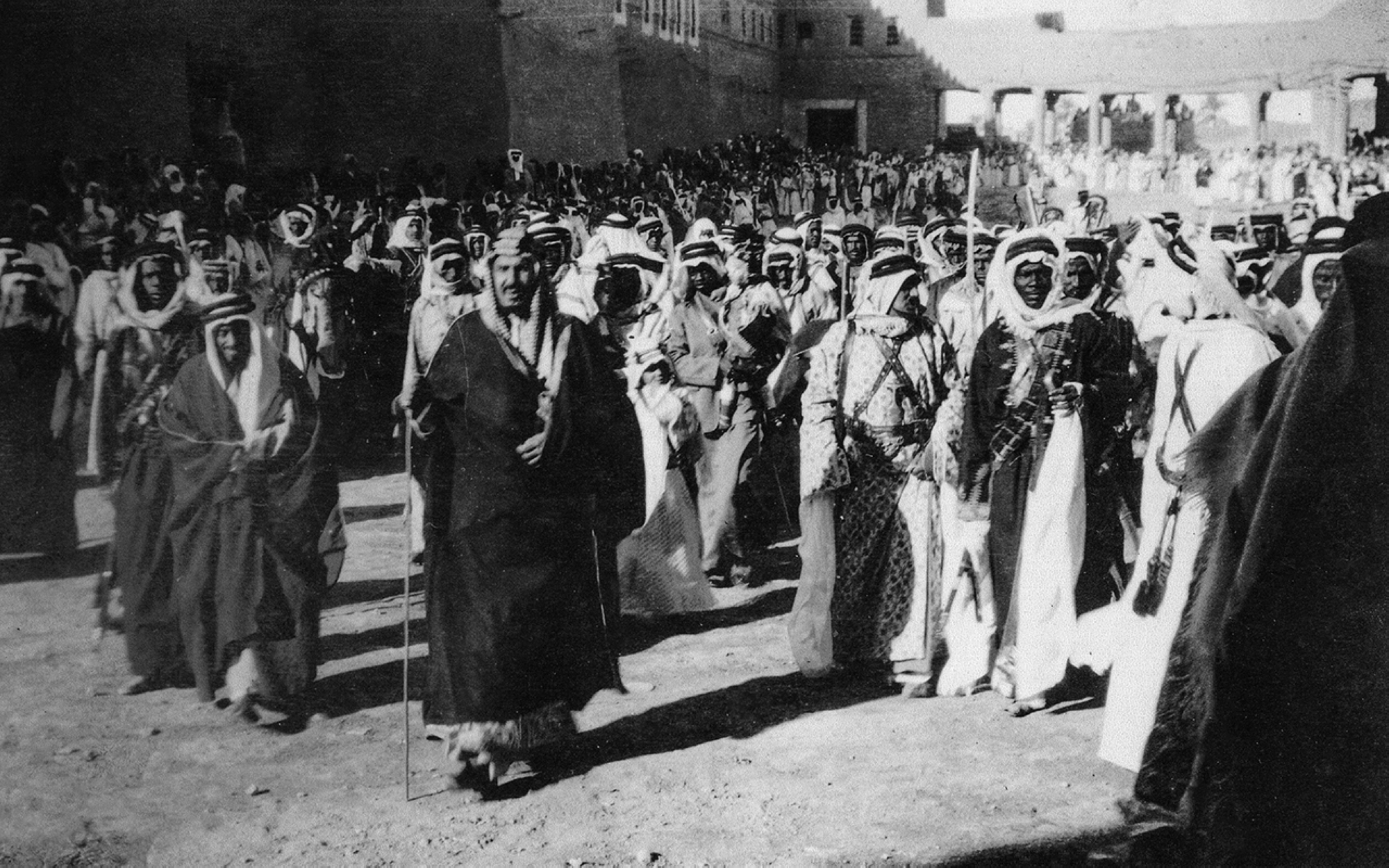
Morals and humanity of King Abdulaziz
Commitment to religion
King Abdulaziz Al Saud was not just the founder of a state, but also a continuation of the first and second Saudi states, which themselves extended the foundational state established in the Arabian Peninsula by the Prophet Muhammad (PBUH), to spread religion and establish security. King Abdulaziz restored the pillars of stability that had dissipated during the era of small states and broadly encompassed the majority of the Arabian Peninsula. He built on national foundations free from ideological influences after the chaos that had pervaded the region prior.
Dealing with his opponents
King Abdulaziz was known for his ability to blend firmness with forgiveness, often pardoning his fiercest opponents even in the harshest of circumstances. He took care to maintain the dignity and status of the notables and princes who had fallen on hard times, ensuring their respect among the people. He also had a unique approach to dealing with his adversaries after pardoning them by bringing them close to him and influencing them with his commendable manner and treatment. This approach often turned them into some of his most loyal supporters, to the extent that those who once incited against him later became his advocates.
His concern for family and children
King Abdulaziz was dedicated to his family, ensuring their presence at the daily lunch meal, occasionally joined by his married daughters and sons. Everyone would also have dinner with him after Maghrib prayer. His Crown Prince, Prince Saud, sometimes joined these dinners, as he would host meals for others at his home. Similarly, Prince Faisal, the Vice King in Hejaz, would join if he were in Riyadh. King Abdulaziz did not raise his children in luxury; instead, he held an annual family meeting for both men and women to offer advice and remind them of the country's foundation on the Holy Quran and the Sunnah of the Prophet, urging them to adhere to these principles and maintain them. He also guided them to treat people kindly, care for the poor and needy, uphold people's rights, and fulfill their obligations.
King Salman Bin Abdulaziz, the Custodian of the Two Holy Mosques, recalls from his childhood that his father always monitored them in all matters, especially in prayer and study, as they would perform all the prayers with him.
King Abdulaziz took great interest in the education of his family and his people. He tasked scholars and teachers with their education, including Mohammed Bin Abdullah al-Sinari. He then established a school for his sons within the palace and appointed teachers for it, including Professor Ahmed al-Arabi at the start of the Princes' School, Sheikh Abdullah Khayat as the school director, and others like Ahmad Bin Ali al-Kadhimy, Saleh Khazami, and Abdulhamid al-Kadhimy. Keen on monitoring his sons' attendance, he assigned Mohammed Bin Muslim to stand in front of the school to oversee their entry and report any absences or tardiness to him. King Abdulaziz regularly visited his sons' school to check on their academic performance and that of their teachers. He made sure to attend the Holy Quran completion ceremony for his sons, held at his home or in Ghar al-Ma'zar, and the certificate distribution ceremony at the end of the year, or he would send one of his elder sons to attend in his stead. Sources, quoting King Faisal, mention that King Abdulaziz’s educational approach was a blend of strictness and compassion, treating his sons and the children of his people equally, as all were the same to him. He was known for his straightforward speaking style, often joking with his sons and companions.
Justice and fairness
King Abdulaziz was renowned as a just and fair ruler, diligently ensuring justice in all aspects because it is an integral part of Islamic faith and governance. He never tolerated injustice, and many stories highlight his fairness and humanity. For instance, sources recount an episode where he observed a weary camel in a caravan near his camp in al-Uqayr. Concerned, he summoned the owner and instructed him to release the camel to graze and rest, and not to force it back into the caravan, showing his compassion. In another humanitarian gesture, King Abdulaziz personally advocated for a needy individual. An elderly woman from Makkah al-Mukarramah approached him at his palace gate, distressed about her inheritance case and lacking representation. He took the documents from her and personally ensured that her case was pursued in court until it was resolved.
King Abdulaziz demonstrated profound humanity and concern for the welfare of his citizens throughout his reign. During a period when the Saudi economy was struggling and financial resources were scarce, making it difficult to pay government employee salaries, he sought advice from his advisors, Abdullah al-Sulaiman (Minister of Finance) and Hafiz Wahba. They suggested laying off half the employees so that the state could manage to pay the remaining half. However, King Abdulaziz found this proposal unacceptable and responded sharply, challenging them to dismiss one another as they had advised. He stated that laying off people in such an economic crisis would devastate their lives, affecting their welfare and livelihoods. Consequently, he decided to reduce all salaries by half instead, allowing everyone to retain their jobs until the economic situation improved. In 1934, when wireless communication employees sent a telegram informing him of the severe hardships they and their families faced due to global economic conditions affecting the Saudi economy, he promptly instructed the Minister of Finance to urgently look into their situation and ensure they were not overlooked.

Aspects of King Abdulaziz's life
Children of King Abdulaziz
King Abdulaziz married many wives from many tribes and notable families and he had a number of sons and daughters, as follows:
Turki (the first), Saud, Faisal, Fahd (the first), Mohammed, Khalid, Nasser, Saad, Mansour, Fahd (the second), Abdullah, Bandar, Musaid, Abdulmohsen, Meshaal, Sultan, Abdulrahman, Mutaib, Talal, Mashari, Badr, Turki (the second), Nawaf, Nayef, Fawaz, Salman, Majid, Thamer, Mamdouh, Abdulelah, Sattam, Ahmed, Mashhour, Hazloul, Abdulmajeed, Muqrin, Hamoud, Muneera, Nourah (the first), Sara, Sheikha, Alanoud, al-Jawhara (the first), Delail, Moudhi, Hessa, al-Bandari, Qumasha, Nouf, Syitah, Haya, Sultana, Nourah (the second), Mashael, Madaawi, Jawza', Luluwah, Latifah, Jawahir, al-Jawhara (the second), Abta, Shu'aia, Falwah, Tarfah, and Fahda.
Titles and decorations of King Abdulaziz
King Abdulaziz was known by several titles, but he favored the nickname "Abu Turki" over more formal titles such as "His Highness the Sultan" or "His Majesty the King." He also took pride in his sister, Princess Nourah, often saying, "I am the brother of Nourah." Additionally, he held several other titles, which are:
Governor of Najd and leader of its Tribes in 1902.
Sultan of Najd in 1921.
Sultan of Najd and its dependencies in 1922.
King of Hejaz and Sultan of Najd and its dependencies in 1926.
King of Hejaz and Najd and its dependencies in 1927.
King of the Kingdom of Saudi Arabia in 1932.
King Abdulaziz received a number of orders:
From the United Kingdom: The Most Honorable Order of the Bath and Order of the Star of India.
From the French Republic: The Grand Cross of the Legion of Honor.
From Italy: The Grand Cross of the Order of Saints Maurice and Lazarus, and the Grand Cross of the Order of the Crown of Italy.
From the Netherlands: The Grand Cross of the Order of the Dutch Lion.
From Iraq: The Order of the Hashemites, and the Grand Cross of the Order of the Two Rivers.
The political approach of King Abdulaziz
King Abdulaziz adopted a political strategy in his governance that was noted by his close associates and sources documenting his life. They noted that he never chose war as the first option against his opponents. He engaged in warfare only as a last resort, after exhausting all peaceful means. His approach from the recapture of Riyadh to the unification and development of the state was centered on national unity for a geographically expansive country capable of asserting strength and sovereignty in the region, particularly in serving the Two Holy Mosques. His methodology was to favor forbearance before confrontation. Throughout the formative years of his rule, King Abdulaziz faced various forms of rebellion, broken agreements, and challenges to his authority, yet he consistently prioritized forbearance over confrontation. During the world wars, he maintained a stance of positive neutrality, successfully protecting his country while many other nations suffered the consequences of the wars.
King Abdulaziz Personal Library
King Abdulaziz was keen on science and culture, and the cultural aspect of the founding king's personality was evident through the vast library he amassed, which contained more than three thousand books collected over his lifetime. The library comprised a diverse collection including writings, periodicals, and rare volumes. He was particularly passionate about interpretations and religious sciences that align with the Holy Quran and Sunnah. He also took an interest in the printing and publishing of books at his own expense. Moreover, he was known for encouraging his sons, scholars, thinkers, and capable individuals to endow books and promote their publication, which contributed to the care of books and supported the movement of publishing and knowledge.
The library, now managed by the King Abdulaziz Foundation for Research and Archives (Darah), responsible for preserving the history and heritage of Saudi Arabia, includes a rare collection of writings and periodicals. King Abdulaziz's dedication to reading and his thirst for knowledge led to the expansion of his personal library, which became an integral part of al-Murabba Palace, located on the first floor. It houses rare manuscripts of great value, inherited from his ancestors, as well as items he received as gifts or purchased. The books in this library, bearing historical inscriptions and covers, reflect King Abdulaziz’s esteem for knowledge. Despite being over a century old, the contents of King Abdulaziz's personal library are well-preserved, thanks to restoration and renewal efforts. The King Abdulaziz Foundation has undertaken the King Fahd Bin Abdulaziz project to restore and bind the books of King Abdulaziz's personal library, which now serves as an important resource for the study of modern Saudi history, particularly regarding King Abdulaziz’s relationship with science and knowledge.
The death of King Abdulaziz
The founding King Abdulaziz Bin Abdulrahman Al Saud passed away after a life spanning about eighty years filled with significant events. He spent his childhood during the reign of the Second Saudi State and witnessed its end in Riyadh. In his youth, he moved away from his family's base, during which his leadership qualities were formed, leading him to establish the modern Saudi state. He spent thirty-two years unifying its provinces and ruled for a total of fifty-four years. He passed away on November 8, 1953, in Taif, and his body was transported to Riyadh to be buried in al-Oud Cemetery. Following his death, his son, then-Crown Prince Saud Bin Abdulaziz, assumed the throne.
Institutions named after King Abdulaziz
Many entities in Saudi Arabia bear the name of King Abdulaziz, including:
King Abdulaziz University (KAU) in Jeddah City.
King Abdulaziz City for Science and Technology (KACST) in Riyadh City.
King Abdulaziz Foundation for Research and Archives (Darah) in Riyadh City.
King Abdulaziz International Airport in Jeddah City.
King Abdulaziz Public Library in Riyadh City.
King Abdulaziz Center for National Dialogue in Riyadh City.
King Abdulaziz and his Companions Foundation for Giftedness and Creativity "Mawhiba".
King Abdulaziz Military Academy in Riyadh City.
King Abdulaziz Medical City in Jeddah City.
King Abdulaziz Medical City in Riyadh City.
King Abdulaziz Port in Dammam City.
King Abdulaziz Endowment in Makkah al-Mukarramah.
King Abdulaziz Arabian Horse Center in Riyadh City.
King Abdulaziz Complex for Endowment Libraries in al-Madinah al-Munawwarah.
King Abdulaziz Air Base in the Eastern Province.
King Abdulaziz Naval Base in al-Jubayl.
Saqr al-Jazira Aviation Museum in Riyadh City.
King Abdulaziz Center for World Culture 'Ithra' in Dhahran.
In addition to a number of government hospitals in various provinces of Saudi Arabia.
Related quizzes
Related articles

